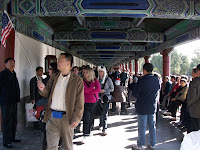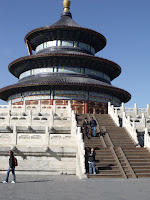The Temple of Heaven
天壇
It was a beautiful morning. We left the warm confines of the hotel lobby and we set out on our way to the Temple of Heaven.
The flags were waving in the breeze the air was clean and clear after a nighttime rain. It was the first and only clear day we would experience in China. By early evening the smog would be retuning.
We were whisked cross town to the park grounds known as the Temple of Heaven.
The Temple of Heaven is an Imperial Sacrificial Altar in Beijing, it is also a UNESCO World Heritage Site
The temple complex was constructed from 1406 to 1420 during the reign of the Yongle Emperor, who was also responsible for the construction of the Forbidden City in Beijing. The complex was extended and renamed Temple of Heaven during the reign of the Jiajing Emperor in the 16th century. The Jiajing Emperor also built three other prominent temples in Beijing, the Temple of SunTemple of Earth (地壇)in the north , and the Temple of Moon (月壇)in the west . The Temple of Heaven was renovated in the 18th century under the Qianlong Emperor. Due to the deterioration of state budget, this became the last large-scale renovation of the temple complex in the imperial time. (日壇)in the east , the
 The temple was occupied by the British-French Alliance during the Second Opium War. In 1900, during the Boxer Rebellion, the Eight Nation Alliance occupied the temple complex and turned it into the force's temporary command in Beijing, which lasted for one year. The occupation desecrated the temple and resulted in serious damage to the building complex and the garden. Robberies of temple artifacts by the Alliance were also reported. With the downfall of the Qing, the temple complex was left unmanaged. The neglect of the temple complex led to the collapse of several halls in the following years.
The temple was occupied by the British-French Alliance during the Second Opium War. In 1900, during the Boxer Rebellion, the Eight Nation Alliance occupied the temple complex and turned it into the force's temporary command in Beijing, which lasted for one year. The occupation desecrated the temple and resulted in serious damage to the building complex and the garden. Robberies of temple artifacts by the Alliance were also reported. With the downfall of the Qing, the temple complex was left unmanaged. The neglect of the temple complex led to the collapse of several halls in the following years.In 1914, Yuan Shikai, then President of the Republic of China, performed a Ming prayer ceremony at the temple, as part of an effort to have himself declared Emperor of China. In 1918 the temple was turned into a park and for the first time open to the public. Japaneses army occupied the park during the Second Sino-Japanese War and set up a site for bio-warfare development, which was destroyed by the Japanese before their retreat.
 The Temple of Heaven was inscribed as a UNESCO World Heritage Site in 1998 and was described as "a masterpiece of architecture and landscape design which simply and graphically illustrates a cosmogony of great importance for the evolution of one of the world’s great civilizations..." as the "symbolic layout and design of the Temple of Heaven had a profound influence on architecture and planning in the Far East over many centuries."
The Temple of Heaven was inscribed as a UNESCO World Heritage Site in 1998 and was described as "a masterpiece of architecture and landscape design which simply and graphically illustrates a cosmogony of great importance for the evolution of one of the world’s great civilizations..." as the "symbolic layout and design of the Temple of Heaven had a profound influence on architecture and planning in the Far East over many centuries." The surroundings of the Temple of Heaven is now a very popular park for exercising.
The Temple grounds cover 2.73 km² of parkland and comprises three main groups of constructions, all built according to strict philosophical requirements:
- The Hall of Prayer for Good Harvests (祈年殿) is a magnificent triple-gabled circular building, 36 metres in diameter and 38 metres tall, built on three levels of marble stone base, where the Emperor prayed for good harvests. The building is completely wooden, with no nails. The original building was burned down by a fire caused by lightening in 1889. The current building was re-built several years after the incident.Panorama with the Hall of Prayer for Good Harvests in the center, viewed from the South
 Panorama of the three main halls
Panorama of the three main halls
- The Imperial Vault of Heaven (皇穹宇) is a single-gabled circular building, built on a single level of marble stone base. It is located south of the Hall of Prayer for Good Harvests and resembles it, but is smaller. It is surrounded by a smooth circular wall, the Echo Wall, that can transmit sounds over large distances. The Imperial Vault is connected to the Hall of Prayer by the Vermilion Steps Bridge, a 360 meter long raised walkway that slowly ascends from the Vault to the Hall of Prayer.

- The Circular Mound Altar (圜丘坛) is the altar proper, located south of the Imperial Vault of Heaven. It is an empty circular platform on three levels of marble stones, each decorated by lavishly carved dragons. The numbers of various elements of the Altar, including its balusters and steps, are either the sacred number nine or its nonuples. The center of the altar is a round slate called the Heart of Heaven (天心石) or the Supreme Yang (太阳石), where the Emperor prayed for favorable weather. Thanks to the design of the altar, the sound of the prayer will be reflected by the guardrail, creating significant resonance, which supposed to help the prayer communicate with the Heaven. The Altar was built in 1530 by the Jiajing Emperor and rebuilt in 1740.

In ancient China, the Emperor of China was regarded as the Son of Heaven, who administered earthly matters on behalf of, and representing, heavenly authority. To be seen to be showing respect to the source of his authority, in the form of sacrifices to heaven, was extremely important. The temple was built for these ceremonies, mostly comprising prayers for good harvests.
 Twice a year the Emperor and all his retinue would move from the Forbidden city through Beijing to encamp within the complex, wearing special robes and abstaining from eating meat. No ordinary Chinese was allowed to view this procession or the following ceremony. In the temple complex the Emperor would personally pray to Heaven for good harvests. The highpoint of the ceremony at the winter solstice was performed by the Emperor on the Earthly Mount. The ceremony had to be perfectly completed; it was widely held that the smallest of mistakes would constitute a bad omen for the whole nation in the coming year.
Twice a year the Emperor and all his retinue would move from the Forbidden city through Beijing to encamp within the complex, wearing special robes and abstaining from eating meat. No ordinary Chinese was allowed to view this procession or the following ceremony. In the temple complex the Emperor would personally pray to Heaven for good harvests. The highpoint of the ceremony at the winter solstice was performed by the Emperor on the Earthly Mount. The ceremony had to be perfectly completed; it was widely held that the smallest of mistakes would constitute a bad omen for the whole nation in the coming year.One of the regrettable elements of traveling with a tour group is that there is often too much emphasis on factory tours and shopping, consequentially your time at each of the cultural or historical venues visited is truncated, as was the case, as earlier mentioned, with our tour group at the Great Wall and other stops and again here at the Temple of Heaven. Of the three areas of the Temple of Heaven complex noted above we would visit only one. The Hall of Prayer for Good Harvests and the open areas we passed while getting in and getting out.
When we arrived there were people all over the place exercising, dancing, telling stories, playing games etc. and of course the ubiquitous vendors hawking souvenirs to the tourists.
The Panda hats were a popular choice.
I looked oh so charming in mine...but I actually bought it for Mom/Granny. It was quite breezy and a little chilly, so we wanted to keep her warm.
The decorated lintels of the covered walk way were fascinating and beautiful.
We soon arrived at
祈年殿
The Hall of Prayer for Good Harvests.
There on the plaza of the The Hall of Prayer for Good Harvests were huge crowds of visitors and numerous other tour groups from various countries as indicated by the flags carried by their tour guides.
This guy came up to us and gave a thumbs up and said, 'Go USA! Thank you Mr. Bush. We love America!' He said he and his friend were from Iraq. We talked to him for a little while. He seemed a very nice person. I don't recall if he had fled the country or still lived there. (I hope showing his photo here doesn't get him in trouble back home.)
The obligatory photos of our mugs in front of the pagoda.
We met a woman and her 101 year old mother. The people we met in China were generally very friendly and open people who were interested in talking to us, taking pictures of us and/or with us. They wanted to know how we live, what our lives are like and wanted us to enjoy our time in China.
Everyone snapped photos of the two sweet old ladies together, East and West united, even strangers and passersby that were not in our group.
Finally we climbed the stairs to the round plaza and entered the elaborately decorated pagoda, The Hall of Prayer for Good Harvests.
Once we had taken in the views of the surrounding areas from the upper plaza we entered the Temple.
It was immaculately detailed inside and out.
Inside one could see the incredibly detailed ceiling. For more photos of the Temple of Heaven park click here and here.
On the way out and back to the bus there were more people playing games. We stopped breifly and joined in.
Here, below, Dian Thomas (authoress and former regular on the Today Show out of NYC) plays ring toss with an elderly gentleman.
I gave it a try myself, but wasn't terribly accurate on my tosses, the guy had a pretty accurate throw.
There were several men that we saw painting, with water, Chinese calligraphy on the sidewalks and plaza tiles. As the sun warmed the tiles the writing of course would evaporate and disappear.
Just before leaving the park we came across this group of seniors chatting and visiting in the sun. They were amazed at granny's age. As I recall retirement age in China is 50 or 55.
Soon back on the bus we on our way to a restaurant.
Note the guy crossing the street in the middle of all the traffic. This was the norm, remember to look both ways before crossing.
Up Next: The Silk Factory





































































No comments:
Post a Comment